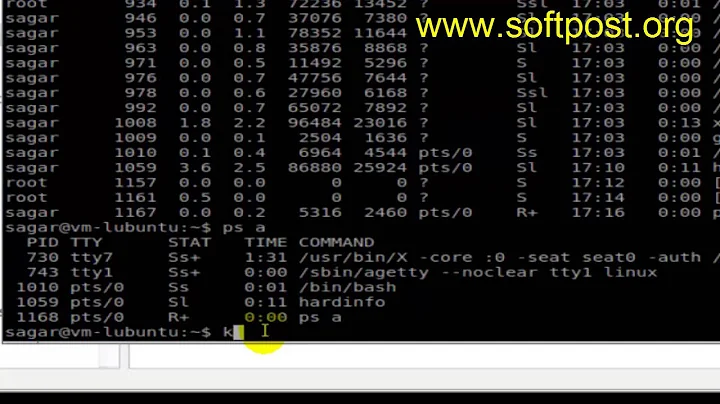how to kill process in Mac OS X and not have it restart on its own
Solution 1
I tried to kill the process by sending it the TERM signal, and that worked. The command was:
sudo kill -15 {PID}
Solution 2
The process you are killing is probably being managed by launchd, the proper way to stop it and have it not restart is to use launchctl unload <path to plist>. The plist that controls that process is in either /Library/LaunchDaemons or /System/Library/LaunchDaemons. If it is a system process and not one of your own, then you will probably have to use sudo to get launchctl to work as desired.
A better way try and stop it might be;
${MYSQL_HOME}/bin/mysqladmin -u root -proot shutdown > /dev/null 2>&1
Solution 3
A couple of comments mention that "launchd is probably involved" - so I thought I'd put this out as an additional answer. As @jarrod-roberson says, you can check if launchd is involved by first running launchctl list | grep mysqld.
An important thing you learn here is whether MySQL was installed with Homebrew or not - Brew stores its launchctl files in a different location than where OSX puts the "regular" services.
On my OSX box, the plist files are in ~/Library/LaunchAgents/ So I ran:
launchctl unload -w ~/Library/LaunchAgents/homebrew.mxcl.mysql.plist
to stop the MySQL server. I had previously looked in /Library/LaunchDaemons/ and /Library/LaunchAgents but didn't find a file with mysqld in its name.
You can also install a brew-based system called services, to manage all Brew-installed services applications, as described in this post - http://robots.thoughtbot.com/starting-and-stopping-background-services-with-homebrew I haven't tried this myself, though, so YMMV.
Solution 4
For me, this worked once I figured out which label I was looking for.
launchctl list | egrep {DESIRED_LABEL}
launchctl remove {DESIRED_LABEL}
Solution 5
Unload the service and stop the daemon:
sudo launchctl unload -w /Library/LaunchDaemons/com.mysql.mysql.plist
Load the service and start the daemon:
sudo launchctl load -w /Library/LaunchDaemons/com.mysql.mysql.plist
Related videos on Youtube
Hristo
Updated on September 17, 2022Comments
-
Hristo over 1 year
When I run
sudo kill -9 [PID]with the proper process ID, the process stops but then is restarted and has a new PID. I'm trying to kill themysqldprocess.How can I mimic the Activity Monitor in killing a process? In the Activity Monitor, when you press "Quit Process", the process permanently stops running, it is totally terminated. I figure that
killwill do the same thing right?I had both the Activity Monitor and the terminal next to each other to see if the command works, but every time I do
sudo kill -9 [PID], the process in Activity monitor doesn't go away, it just refreshes with a new PID.So... how do I kill the
mysqldprocess via the terminal?-
Yoosaf Abdulla over 10 yearsI did it from the activity monitor because the 'kill' command was not recognising the PID. Again unlike your case my mysqld did not restart as soon as I killed it from the Activity monitor.
-
Jan Steinman about 6 yearsOuch! Don't use -9 unless you REALLY need to. It's a violent thing to do to a process. Other signals allow a process to terminate in an orderly manner, but not -9! So it means that RAM buffers don't get flushed to disk, for example. This is a particularly bad thing to do to a database that is in the process of doing work; you'll come back to damaged tables.
-
-
Hristo almost 14 yearsI'm trying to kill the
mysqldprocess -
Hristo almost 14 yearsI'm trying to kill the
mysqldprocess. I'm not sure if that is part of LaunchDaemons... but the following command is the correct way to stop the server from runningsudo /usr/local/mysql/support-files/mysql.server stopbut I'm having problems with that, so I'm trying to kill the process directly. -
 Admin almost 14 yearsif it is being restated after
Admin almost 14 yearsif it is being restated afterkill -9the launchd is probably involved, even if indirectly. you can tell by usinglaunchctl list -
Hristo almost 14 yearsthe list doesn't have "mysql" in it. I will try your command up top.
-
mipadi almost 14 yearsProbably managed by
launchd, then, which will restart it if the process dies. -
JJ_Australia almost 14 yearsRedirect STDOUT and STDERR to /dev/null.
-
Hristo almost 14 yearsUsing
-15as a flag opposed to-9did the job. Thanks for your response! -
Jeff over 8 yearsI had the same problem and was able to solve by removing mysql from launchd via
sudo launchctl unload /Library/LaunchDaemons/com.oracle.oss.mysql.mysqld.plist -
Eugene Morozov over 8 yearsThis worked for me except that is was
com.oracle.oss.mysql.mysqld.plistMy local MySQL was installed from downloading from MySQL, not via homebrew. -
 Patrick about 8 yearsThis is what fixed it for me. Always a pain when you are fighting multiple different ways to run a LAMP stack locally.
Patrick about 8 yearsThis is what fixed it for me. Always a pain when you are fighting multiple different ways to run a LAMP stack locally. -
 micjamking over 7 yearsI had to use the Homebrew path to remove this, i.e.
micjamking over 7 yearsI had to use the Homebrew path to remove this, i.e./usr/local/opt/mysql/homebrew.mxcl.mysql.plist -
Denys Kniazhev-Support Ukraine about 7 yearsThe
launchdlink is now broken. -
 Christia about 7 yearsI can see
Christia about 7 yearsI can seecom.oracle.oss.mysql.mysqld.plistin /Library/LaunchDaemons and have used the commandsudo launchctl unload /Library/LaunchDaemons/com.oracle.oss.mysql.mysqld.plistonly to receive the error message:Could not find specified service -
K. Symbol about 4 yearsThis helps me to finally kill Pulse Secure. Just note that the label for egrep can be partial keywords (like pulse), but the label for remove must be copied from the list output (like net.pulsesecure.pulsetray).


![Your Computer Restarted Because of A Problem on Mac? [Solved!]](https://i.ytimg.com/vi/vcgSWFNNCLg/hq720.jpg?sqp=-oaymwEcCNAFEJQDSFXyq4qpAw4IARUAAIhCGAFwAcABBg==&rs=AOn4CLASZ8eH06rVuU-DNi8v6xuJeLhQJw)

